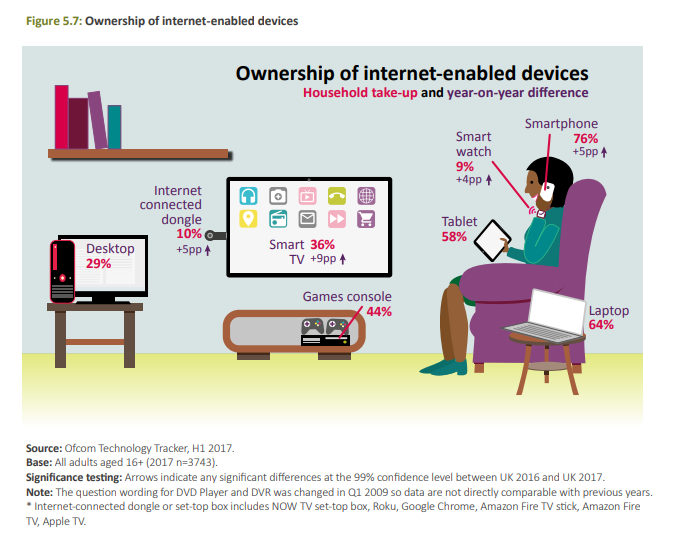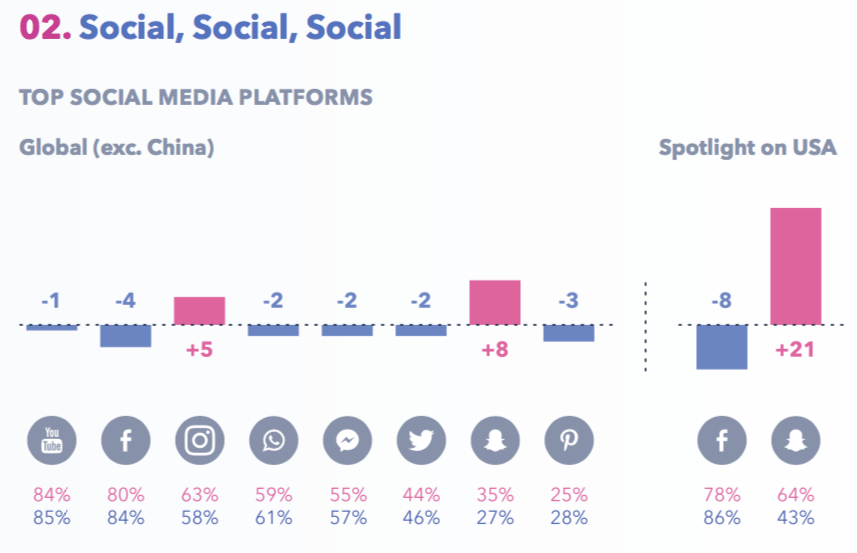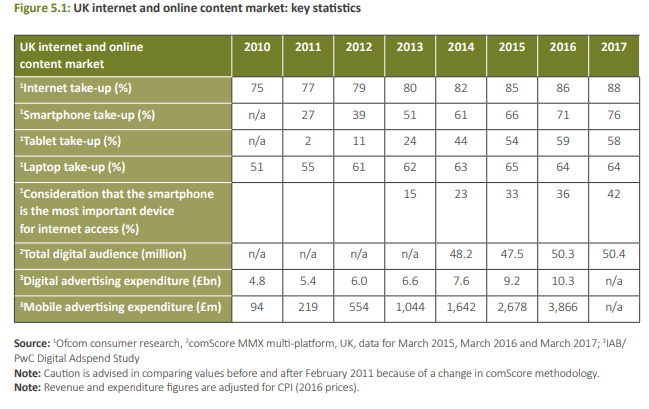Digital marketing continues to evolve in 2018 through to 2019 with new trends for small businesses to utilise, as platforms are updated with new features that allows digital marketers to make use of new tools and features. These digital marketing trends impact how SMEs can engage target audiences, drive online sales and find new customers online.
So what digital marketing trends can SMEs expect throughout 2018 into 2019, and how can you make the most of them in order to help grow your business online? We’ve assessed some of the key digital marketing trends below, and how they impact SMEs in both the short-term and long-term.

Mobile focus
Mobile phones are becoming the most important device to a person. iPads, tablets, laptops and desktop PCs are no longer the primary device someone will use for online tasks.
From Ofcom research, it was found:
- 88% of adults have internet at home
- 53% of over 74s are internet users
- 42% of UK internet users consider smartphones as the most important device for accessing the internet
- 66% of 16-34-year-olds consider the mobile as most important
- 44% of 35-54-year-olds consider the mobile as most important
- 76% of adults own a smartphone – compared to 64% of laptops and 58% for tablets

Video marketing campaigns
Video is becoming much more important to online channels, and is the most eye-catching format of content. Long gone are the days where videos buffered, and mobile websites were a drag to use. Now video is more accessible wherever you are – at home or on the move. And it’s worthwhile considering where your target audience may be.
Whatever platform you are looking to market on, it’s likely video is your best bet in terms of creating the most engaging content. This could be YouTube, Facebook, Twitter, Snapchat, Instagram, or otherwise.
YouTube had a crossplatform reach of 42 million users in March 2017 – viewers logged 728 hours’ worth of total viewing time, which averages to 18 hours per viewer
Video has become so important partially due to technological advancements, but also consumer familiarity. The rise of video-on-demand has impacted other industries and how platforms can engage with viewers. Amazon is moving more into the TV and movie industries alongside the likes of Netflix and other online platforms, which in-turn, impacts the likes of YouTube and Facebook. Even YouTube publishes it’s own content, alongside the millions of user-generated content from individuals and brands.
This shift certainly has an impact on user behaviour, and how we interact with each other and brands online. Plus, video is easier to make than ever before. All you need is a smartphone and maybe a simple app. But creating more professional content also has a low barrier to entry, as any camera can shoot HD video which can easily be edited together.
For SMEs, customers will look for videos related to particular products or services before visiting a store or making a purchase. Videos allow for a more authentic experience that reflects being in-store, and gives them better insight before deciding whether to purchase.
Live Video
Facebook, YouTube, Twitter and many other platforms now make the most of live video. While on-demand video is, of course, always going to be there, live has a different set of benefits.
And big businesses have caught onto this. Twitch is now owned by Amazon which is pushed via Amazon’s Prime. YouTube has many live events shown live. Social channels all allow users to broadcast live. This all helps push the live video trend.
Live internet video will account for 13 per cent of the total video traffic in 2018 according to Cisco.
Live video is in the moment, and is more authentic. Most importantly, it is much more “real” to a customer than something that is heavily edited. And being there while it is on-air can be a lot more evocative – and encourages engagement with both the brand and other viewers.
Think about the kind of content your customers may wish to see live. While webinars have long been popular with businesses, similar sorts of “live” videos can be produced to help market your brand.
Data collection and customer protection
The GDPR is in effect and data protection has never been a hotter topic. While the deadline has been and gone and businesses, for the most part, are compliant, there will still be some that aren’t.
When the GDPR-related fines start inevitably flooding in, you can guarantee it will become a hot topic once again, and more businesses will double down on efforts to ensure customer data is protected.
It’s important that brands make it very clear that customer data is fully secure, as it helps with conversions and for future marketing campaigns.
AI
AI has been around for some time now, but it hasn’t quite hit the mainstream for SMEs quite yet. But this is sure to change over the next year or so.
More platforms are making the most of it for advertising and other marketing methods. Ads can be automated to ensure they receive the best placements and bids, while customers can also receive timely updates from AI.
Chatbots are becoming more popular with brands, as Facebook Messenger now has a host of bots which can help consumers make decisions, make a purchase, or find information. Think about such things as cinema listings, or pizza orders. Customers can simply message a bot to ask when a film is on, or to send a pizza to their front door. Without even touching a website.
Customer support is also benefitting from the rise in AI, allowing simple questions to be answered instantly. This helps alleviate human customer support time to be spent on queries that may be more complex, while also giving customers instant access to information without delving too deep into a website.
Voice search
Voice search has been growing, but it’s set to become even more important. There are 1 billion voice searches per month according to Alpine.AI. Microsoft stated that Cortana has 133 million monthly users.
As more people become comfortable with the concept, and more people have smart devices, it will become more integral to daily life.
As for voice-specific devices such as the Amazon Echo, Google Home and otherwise, they are becoming more prominent. Advertised on television a lot, and receiving a lot of real estate in the shops. These companies are pushing these devices into the public, so the popularity will spread in the near future.
This means SEO will change, as brands will need to ensure they rank for long-tail keywords and phrases that match how people would search via voice.
Google may even release a voice search algorithm. As it stands, video is only based on keywords and labels attributed to the video, but voice and video quality may come into the SEO mix.
Rise and fall of different social platforms
Facebook could fall, but Instagram is definitely on the rise. Which, is still technically Facebook.
We’ve seen Snapchat rise right to the top, to then slowly take a shaky sidestep as some updates angered the wider community. And then we have seen Facebook copy many of the things that make Snapchat so popular (disappearing messages, stories etc), and then subsequently won back ground. Instagram Stories are often favoured by brands over Snapchat Stories, even though this isn’t an “original” concept from Instagram.
Advertisements on Instagram will increase rapidly, especially due to limited organic reach as it becomes a more ad-driven space.

So there’s always a chance other platforms could become much bigger. The graph above shows the top platforms, which would have looked very different even a few years ago. While Facebook almost seems too big to go down, how much time people spend on the platform is dropping, though whether Facebook can combat this is another thing that is yet to be seen.
Increased spend on advertising
Ads are becoming more important to businesses, whether that’s on Google, social media or otherwise. Advertising spend is on the rise in the UK:
- UK expenditure for online advertising increased 20% year on year to £10.3bn in 2016
- Mobile advertising expenditure grew 44% to £3.9bn in 2016, making up 38% of total internet advertising
- Mobile display advertising accounted for 51% of all online display advertising

Social media platforms are constantly changing, and it can be a struggle to keep up. While businesses who post regularly may feel they are doing enough, sadly the organic posts on certain platforms are having diminishing returns.
As organic posts are limited, spend will go up. Facebook has limited the audiences for organic posts, and conveniently this means spending money to sponsor posts is often the only way to reach your audience. While this may be enough for some business owners to consider dropping social media altogether, this is usually the wrong move. There is a good opportunity to find new customers, engage with existing ones, and generate revenue through sponsored posts and social advertising.
Social media has become less of a nice addition to the marketing mix, to an absolute necessity. And advertising on these platforms has become even more important than before.
Storytelling
“Stories” have become a big part of social platforms. Initially found on Snapchat, Facebook shamelessly copied the feature onto Facebook via Messenger, Whatsapp and Instagram. Even YouTube has introduced “Reels”, and Google has released AMP stories in the search results.
The concept of stories lends itself more to storytelling and behind the scenes snippets, rather than heavily-curated, permanent posts on your channels. There’s no visible engagement, and they tend to fill up a device’s screen, so it’s a different format entirely. Behind the scenes snippets can often be very nice to see – whether that’s at your business, of your products in use, or otherwise.
Generation Z
While millennials are the current focus for many brands, Gen Z will be taking over soon.
Generation Z is usually defined as those born between the mid-90s and mid-2000s. It will be interesting to see how this develops, as even now, someone who was born in 2000 is 18. Generation Z hasn’t really experienced life without high-speed internet, access to the internet wherever they are via smartphones, and other technological benefits that those who were born even 5 or 10 years before did not have at some stage.
This will mean there will be behavioural changes in how they interact with brands online, and how they spend their money. While this won’t affect all brands, many businesses will consider is essential to appeal to younger demographics. And Gen Z will be different to millennials in some ways, but there will still be similarities that carry across.
There are sure to be many more digital marketing trends that come out of the woodwork in time – but these are some of the most important for SMEs. While huge corporations will likely be using the latest and greatest things in 2019, many tools simply aren’t available to or make sense for SMEs. But that doesn’t mean you can’t compete.
It’s an exciting time for many marketers, with limitless opportunities to help grow online businesses. All that matters is you don’t get left behind by the competition who are on top of the latest developments and tools that can help reach new customers.


